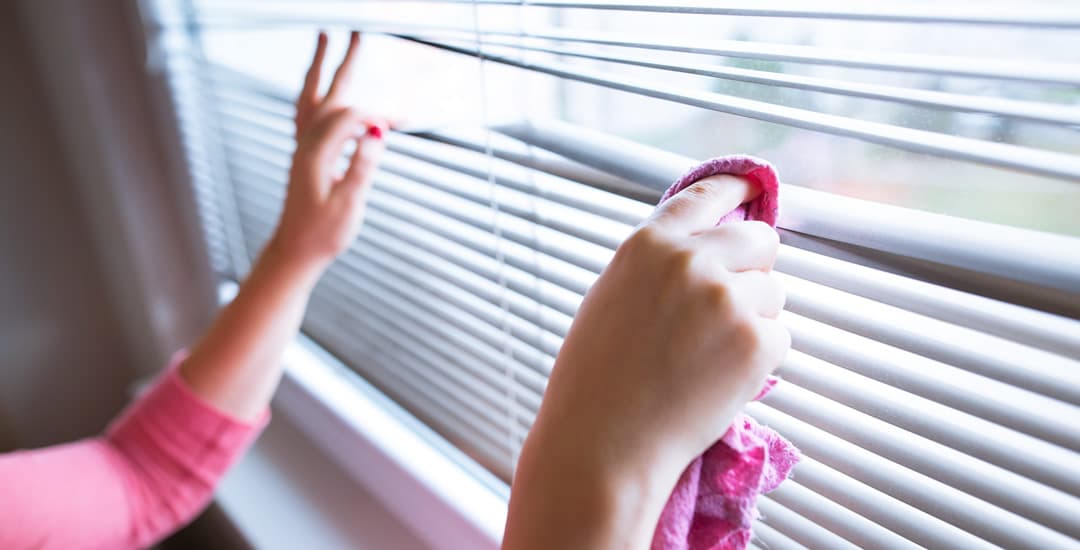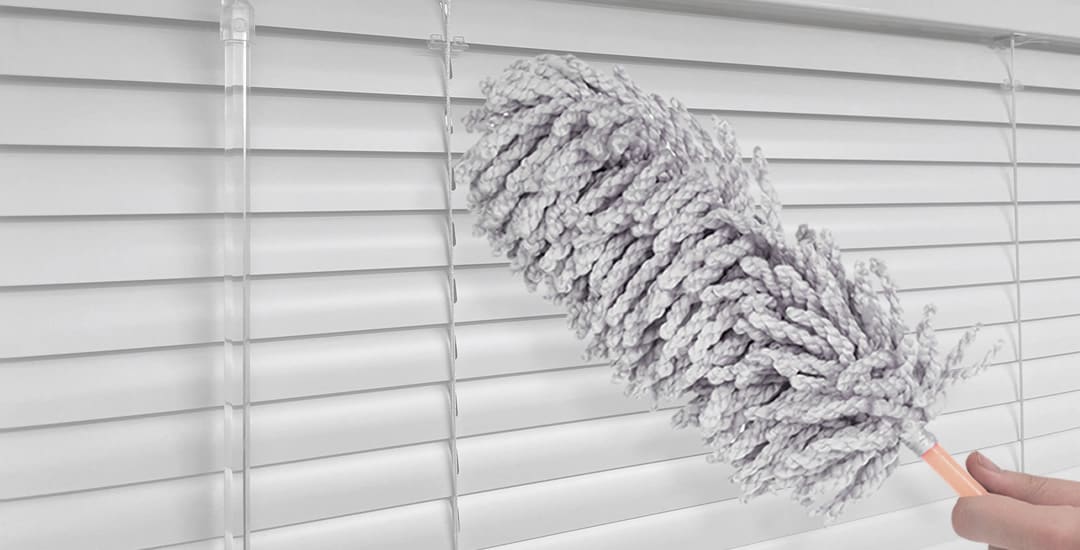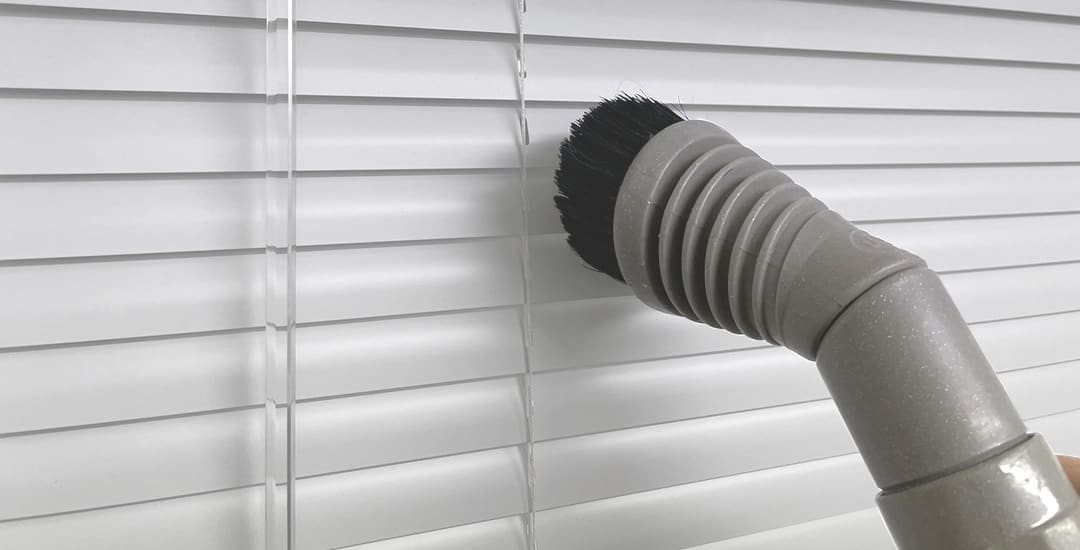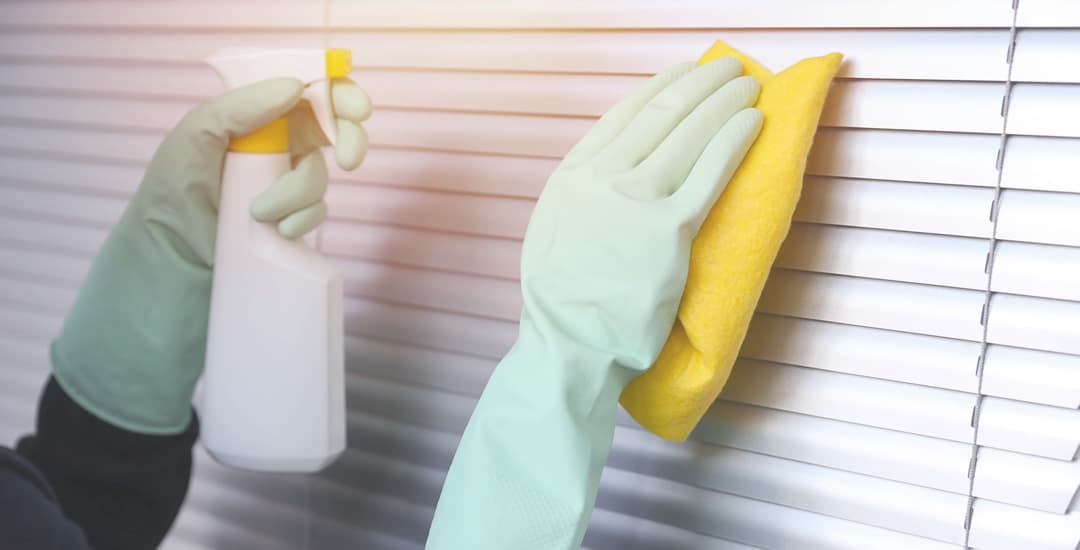
There are a great many plus-points to Venetian blinds, but the propensity of their horizontal slats to attract dust like my credit card attracts shoes is not one of them. The best way to clean Venetian blinds that are just dusty is with a duster or a brush attachment on a vacuum cleaner, as this doesn’t really warrant a full-on wash with water.
If your Venetian blinds are grimy, very marked and stained, or otherwise beyond the point at which thoughts and prayers are going to save them, you might also want to check out my accompanying blog post on how to clean aluminium Venetian blinds that are heavily stained or very grimy.
How to clean aluminium Venetian blinds with a duster

The best way to clean aluminium Venetian blinds if you just need to remove a light layer of dust is with a feather duster; and the excuse to buy a genuine 60s artifact and keep it to hand for Ken Dodd impressions should be incentive enough for most.
If you’re houseproud and dust your blinds as standard every week or two, a feather duster is all you’re ever going to need for the job.
On the other hand, if, like me, you only dust if someone is coming over and try to discourage visitors for this same reason, the new fur coat you suddenly notice that your blind has begun to sport at some point is apt to both fascinate and repel you.
A feather duster probably isn’t going to cut it by this point, so you’ll want a soft cloth or duster mitt or even (and frankly I think the feather duster crowd have some competition here), a sock over your hand. If you don’t automatically start doing the sock puppet motions if this is the path you go down, well I’m seriously concerned for your wellbeing right now.
If you use a duster made of microfibre, this reduces the amount of static you introduce to the blind while you dust, so that it is less keen to attract dust again immediately. You can also run your clean Venetian blind’s slats over with a tumble dryer sheet to negate static after you’ve dusted them too! This was a Mrs Hinch window blind cleaning tip by the way, before everyone shouts at me for stealing the idea.
Anyway, the best way to clean Venetian blinds is with the slats in the closed position, going from the middle of each slat towards the outer edge on one side, and then from the middle again out the other way. This helps to wipe the dust off the blind rather than just smearing it around.
How to clean Venetian blinds with a vacuum cleaner

If you’ve broken out the hoover and anything that doesn’t run away fast enough is fair game and/or you want to wind up the dog, you can also clean aluminium Venetian blinds with a vacuum cleaner’s brush attachment, with care.
There’s a fine line between making just enough of a hash of the cleaning that you’re not asked to do it again, versus sleeping on the sofa for a week so that you can be faced with the results of your laziness every time you open your eyes.
Don’t try to use just a regular tube-y sucky-type attachment on Venetian blinds; if you don’t have a brush attachment it’s manual dusting or a week on the couch, as a regular plastic tube might potentially scratch the blind’s slats and mess up the finish.
Also, set the vacuum’s power to the lowest, least aggressive suction setting before you aim it at your Venetians. If your vacuum only has one setting and it requires permission from the Met Office before you use it as it’s apt to create its own weather phenomenon, it might also pull your slats out of shape or leave them with kinks and dents in them.
This kind of thing is why I humbly suggest that the best way to clean Venetian blinds is with a duster rather than setting Henry on it, but if you can get the power setting on your vacuum low enough and you proceed with caution, you should be fine.
- To clean Venetian blinds with a vacuum cleaner, put the slats into the “closed” position and use the brush attachment to work from the top of the blind to the bottom, running the brush lightly from one side of each slat to the other.
- When you’ve done this on the front of the blind, tilt the slats the other way and repeat the same process so you’re covering the reverse of the slats; but work from the bottom of the blind to the top this time to avoid the risk of catching and bending slats at the point where they overlap.
How to remove stains from Venetian blinds

Finally, if your problem is a couple of localised spots or stains on a Venetian blind rather than a layer of dust, here’s how to sort it.
The good news is that there are not many stains or marks that can’t be removed from an aluminium Venetian blind, as long as they’re surface stains and not chips or scratches.
You can remove stains from Venetian blinds by using something like a glass cleaning spray, washing up liquid, or a mix of water and vinegar. If you’re one of those people (I am one of those people) who think that baby wipes are good for everything from taking off makeup to ensuring you never have to properly polish your shoes, then even a baby wipe can do the trick too.
Whatever you’re using to tackle the stain though, use your other hand to support the reverse side of the slat so that it doesn’t bend or kink while you rub the stain.
Also, if you’ve got a spot in an awkward place (I had one on the inside of my nose once, which I wanted to share although that’s not actually what I meant in this context) you can use a cotton bud bent into whatever position is appropriate to get into small or awkwardly positioned bits of the slats too.




